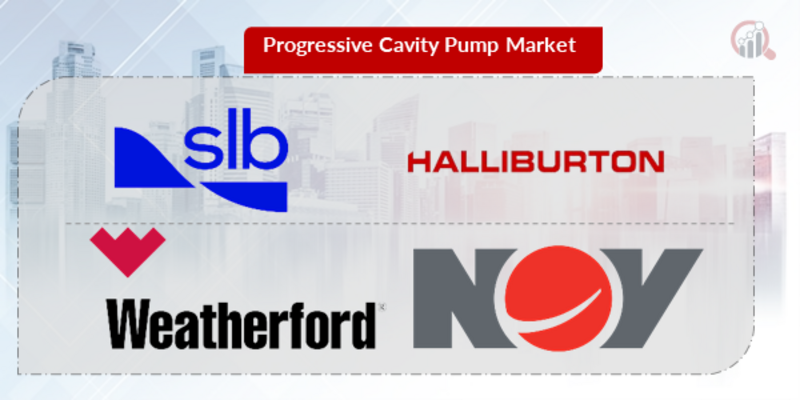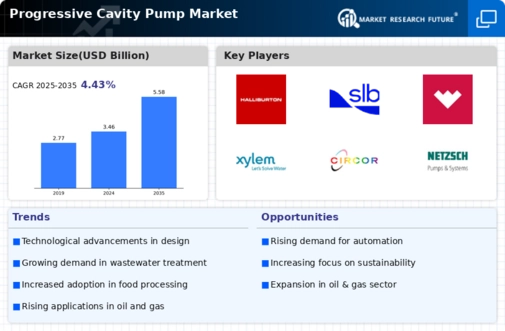Top Industry Leaders in the Progressive Cavity Pump Market

*Disclaimer: List of key companies in no particular order
The progressive cavity pump (PCP) sector, although niche, is experiencing steady growth and witnessing a dynamic interplay between established entities and new market entrants. Renowned for their efficient handling of viscous and abrasive fluids, PCPs find applications across diverse industries such as oil & gas, water & wastewater treatment, food & beverage, and chemical processing. This report thoroughly examines the competitive landscape of the PCP market, providing insights into key player strategies, market share determinants, emerging trends, and the overall competitive scenario.
Market Consolidation and Leading Players: The PCP market displays a moderate level of consolidation, with a select group of major players commanding substantial market share. Prominent among these players are:
National-Oilwell Varco Inc. (NOV): A leading provider of oilfield services, NOV delivers PCPs through its Moineau brand, renowned for reliability and durability in challenging environments.
Schlumberger Limited: Another giant in oilfield services, Schlumberger's Artificial Lift product line features Reda PCP systems, recognized for advanced automation and data analytics capabilities.
Xylem Inc.: A leader in water technology, Xylem's Godwin brand dominates the PCP market for water & wastewater treatment, known for efficient handling of sludge and challenging fluids.
NETZSCH Group: A German pump manufacturer specializing in demanding applications, NETZSCH offers a diverse range of PCPs for the food, chemical, and other industrial sectors.
PCM Group: A French company with a strong presence in oil & gas and food & beverage, PCM's PCPs are known for innovative designs and a focus on energy efficiency.
Factors Influencing Market Share: Several factors play a pivotal role in determining market share within the PCP market:
Emerging Trends and Player Strategies: The PCP market is currently experiencing several noteworthy trends:
Competitive Landscape and Future Outlook: The competitive landscape of the PCP market is expected to remain dynamic in the forthcoming years. Key players are likely to concentrate on:
The overall outlook for the PCP market is optimistic, driven by increasing demand from various end-user industries and the adoption of new technologies. The market is anticipated to grow at a steady Compound Annual Growth Rate (CAGR) of around 5% in the coming years, with Asia Pacific and the Middle East emerging as key growth engines.
Conclusion: The progressive cavity pump market presents a lucrative opportunity for both established players and new entrants. A comprehensive understanding of the competitive landscape, key player strategies, and emerging trends is imperative for success in this market. By focusing on technological innovation, expanding into new applications, and providing reliable and sustainable solutions, PCP manufacturers can secure their position in this dynamic and growing market.
Additional Notes: This report is grounded in publicly available information and industry research reports.
The market size and growth forecasts may vary depending on the source.
The list of key players is not exhaustive.
Industry Developments and Latest Updates:
Halliburton (US):
- Nov 2023: Announced a strategic partnership with Circor International to develop next-generation PCPs for high-pressure, high-temperature oil and gas applications. (Source: Halliburton press release)
- Oct 2023: Launched the new iVolve PCP series with improved efficiency and reliability for unconventional oil and gas production. (Source: Halliburton website)
National Oilwell Varco (NOV) (US):
- Dec 2023: Awarded a $50 million contract for PCPs and related equipment for a major shale oil project in North America. (Source: NOV press release)
- Sep 2023: Unveiled the new NOV CentriQuip PCP line designed for heavy oil and high-viscosity fluid handling. (Source: NOV website)
Schlumberger (US):
- Aug 2023: Collaborated with ExxonMobil to develop and test advanced PCP technology for deepwater production applications. (Source: Schlumberger press release)
- Jun 2023: Acquired a majority stake in Progressive Pumps, a leading provider of PCPs for the water and wastewater treatment industry. (Source: Schlumberger website)









